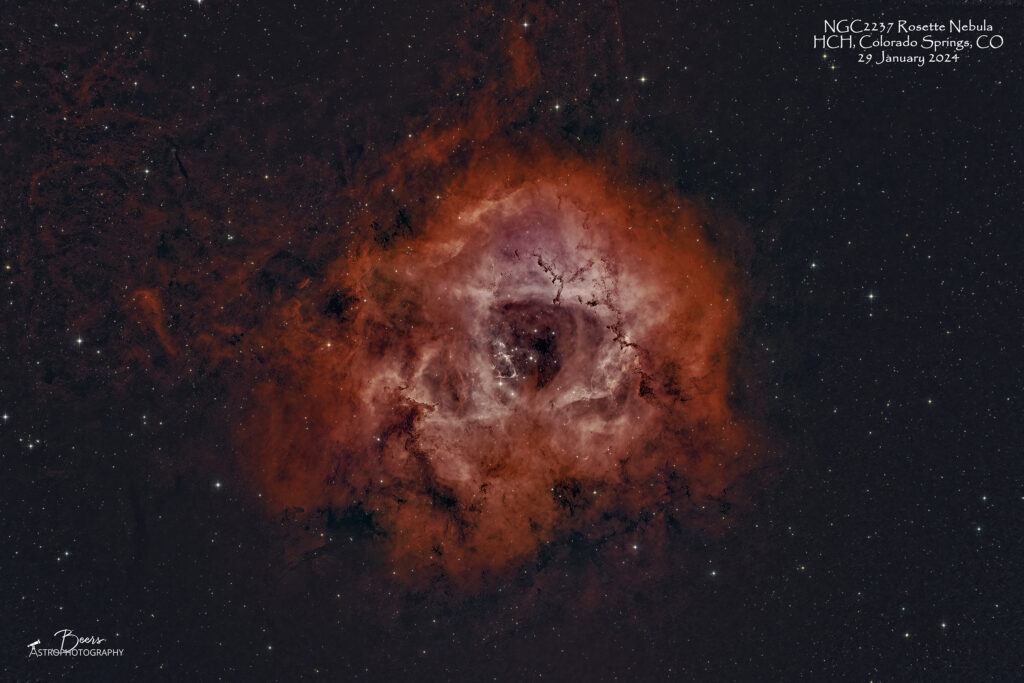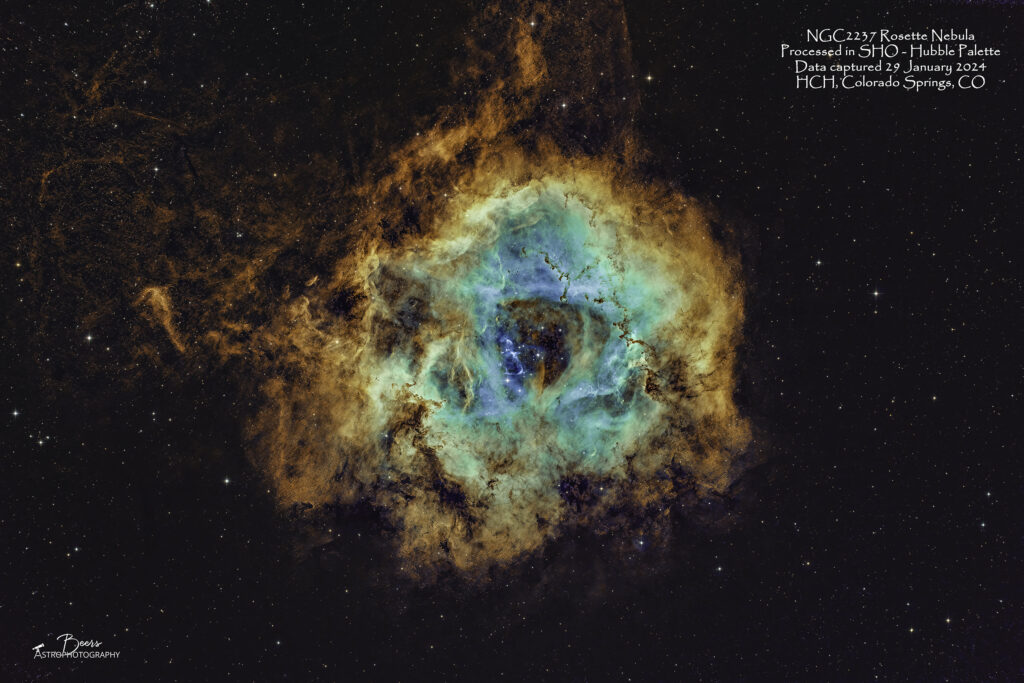

Target Fun Facts
The Rosette Nebula (also known as Caldwell 49) is an H II region located near one end of a giant molecular cloud in the Monoceros region of the Milky Way Galaxy. The open cluster NGC 2244 (Caldwell 50) is closely associated with the nebulosity, the stars of the cluster having been formed from the nebula’s matter.
The complex has the following New General Catalogue (NGC) designations:
- NGC 2237 – Part of the nebulous region (Also used to denote whole nebula)
- NGC 2238 – Part of the nebulous region
- NGC 2239 – Part of the nebulous region (Discovered by John Herschel)
- NGC 2244 – The open cluster within the nebula (Discovered by John Flamsteed in 1690)
- NGC 2246 – Part of the nebulous region
The cluster and nebula lie at a distance of 5,000 light-years from Earth and measure roughly 130 light years in diameter. The radiation from the young stars excites the atoms in the nebula, causing them to emit radiation themselves producing the emission nebula we see. The mass of the nebula is estimated to be around 10,000 solar masses.
A survey of the nebula with the Chandra X-ray Observatory has revealed the presence of numerous new-born stars inside optical Rosette Nebula and studded within a dense molecular cloud. Altogether, approximately 2500 young stars lie in this star-forming complex, including the massive O-type stars HD 46223 and HD 46150, which are primarily responsible for blowing the ionized bubble. Most of the ongoing star-formation activity is occurring in the dense molecular cloud to the south east of the bubble.
On April 16, 2019 the Oklahoma Legislature passed HB1292 making the Rosette Nebula as the official state astronomical object. Oklahoma Governor Kevin Stitt signed it into law April 22, 2019
Other Catalog Designations: SH 2-275, CTB 21, Caldwell 49
Subtype: Super Nova Remnant (SNR)
Distance from Earth: 5000 light years
Apparent Dimension: 1.3 °
Magnitude: 9.0
Constellation: Monoceros
{Target information from: https://en.wikipedia.org/wiki/Rosette_Nebula }
Capture Notes
This was the second night of imaging (after taking a break on Sunday night (28Jan2024) because imaging on Saturday night (two targets – with starting, meridian flip, capturing calibration frames for each) had me a bit worn out) during the clear night streak we had during January 2024’s full moon. My original plan was again to image a nebula target until it set and then switch to Markarian’s Chain to complete the night. After seeing the result of Saturday night’s Markarian’s Chain imaging with the Southern Cross – I decided just the nebula target would be enough!
The capture went well, although I’m still struggling to get the ZWO EAF auto-focuser’s settings dialed in correctly in SGPro. I started the night switching to 7x10second steps from the 9x10second steps I’d used on 27Jan2024 with IC443. It didn’t have the desired effect of eliminating the “ears” of the focusing parabola. I also played with the step size, to no avail. The algorithm continues to select a sub-optimal focusing point as it’s solution. Then throughout the night I got warnings that the autofocusing (that I have set to occur once per hour) had failed. When that happens, the algorithm tries twice and then returns to the starting point (taking up imaging time for no reason). I guess I’m going to have to spend some time really reading the full autofocusing section in the SGP documentation to decide how to proceed.
Equipment
- Imaging (ASI2400-SC-LeX): ZWO ASI2400MC imaging camera with Optolong LeXtreme light pollution filter; (Southern Cross) Askar FRA600 108mm f/5.6 Quintuplet Petzval Flat-Field Astrograph.
- Autofocuser: ZWO EAF Electronic Automatic Focuser – Standard (New 5V Version) (EAF-5V-STD)
- Mount: Rainbow Astro RST-135E (controlled by iHubo ASCOM driver)
- Polar alignment: QHYCCD camera (controlled by Polemaster for polar alignment)
- Autoguiding: Orion 60mm Multi-Use Guide Scope with Orion StarShoot AutoGuider Pro Mono Astrophotography Camera (controlled by PHD2)
All equipment controlled by HP Probook running Sequence Generator Pro v4.3.0.1035
Capture & Processing Notes
Sequence plan: Gain 158, Offset 30, Temp 0°C; 84x5min. Captured 29Jan2024, 1839MST – 30Jan2024, 0250MST. Total exposure time: 7:00hrs.
Processing Workflow: Stacked RAW images with Astro Pixel Processor (APP). Removed stars (for separate processing) with Starnet++ v2. Remainder of processing with Lightroom and Photoshop.
The second image is created from the same data captured on 29Jan2024. Stacked RAW images with Astro Pixel Processor (APP) then used APP’s RGB Combine Tool to create a starting point image. Lightroom and Photoshop processing, especially Photoshop’s Selective Color Adjustment, were used to post-process the SHO Hubble1 image.
Other Images of the Rosette Nebula
Two-tile mosaic – Optolong L-eXtreme Filter first light – 12 February 2022

Capture Notes
This was the first image with the Optolong L-eXtreme filter. Shot from HCH front patio in Bortle 6 Colorado Springs skies, with 87.7% waxing gibbous moon that was essentially adjacent to the target throughout the capture. This image sold me on the virtues of the L-eXtreme filter! The sub-frames during the capture were black-background like in dark skies, and you could see portions of the nebula. In processing, the two tiles’ seam was invisible without any processing heroics!
Equipment
Polar alignment: QHYCCD camera (controlled by Polemaster)
Imaging stream: Orion 8″ f/8 Ritchey-Chretien Astrograph Telescope, Canon EOS Ra with Optolong L-eXtreme Dual-band light pollution filter (first light)
Mount: Sky-Watcher EQ6-R Pro Equatorial Mount
Autoguider: Orion 60mm Multi-Use Guide Scope, Orion StarShoot AutoGuider Pro Mono Astrophotography Camera (controlled by PHD2)
All equipment controlled by HP Probook running Sequence Generator Pro v3.2.0.660.
Sequence Plan
2-tile mosaic. 2 x (ISO1600; 30x300sec). Total=5hrs. Captured, 12Feb2022, from HCH, Colorado Springs, CO.
Rosette Nebula captured with the 600mm telescope – easily fitting in a single frame – 20 Nov 2022

Capture & Processing Notes
Since M31 Andromeda set below the corner of the HCH parapet at about 0215MST and astronomical twilight wasn’t going to begin until 0515MST, decided to use those ~3 hours of darkness to capture some time on the Rosette Nebula. In processing, I couldn’t leave well enough alone – after “completing” the processing, making my commissary run, coming back to it – I decided to add a luminance layer (following Ann Chavtur’s experience with Matt Russell’s instructions for the CSASTRO AP meeting in early November 2022).
Equipment
Polar alignment: QHYCCD camera (controlled by Polemaster)
Imaging stream: Askar FRA600, Canon EOS Ra with Optolong LPro light pollution filter
Mount: Rainbow Astro RC-135E (controlled by iHubo)
Autoguider: Orion 60mm Multi-Use Guide Scope, Orion StarShoot AutoGuider Pro Mono Astrophotography Camera (controlled by PHD2)
All equipment controlled by HP Probook running Sequence Generator Pro v3.2.0.660.
Sequence Plan
ISO1600, 31x5min; Total=2:35hrs. Captured 21Nov2022, 0237MST – 0519MST; from Colorado Springs, Colorado
